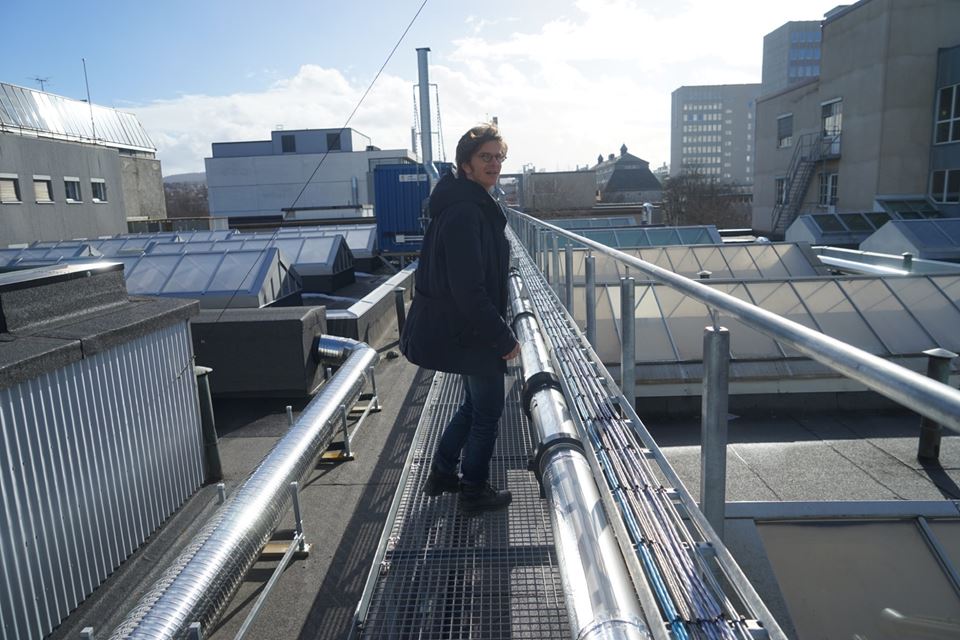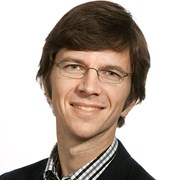CO2 CAPTURE AND STORAGE: At 60 metre-long pipe is shimmering in the spring sunshine on the roof where SINTEF Energy Research is building its own lab to test vertical and horizontal CO2 transport. The experiments are key to achieving the aim of storing large volumes of CO2 safely in the subsurface, and are essential if a climate change crisis is to be prevented.
“In April we began our initial CO2 depressurisation experiments”, says research scientist Svend Tollak Munkejord at SINTEF. “This means that we release the pressure in the pipe and measure how the pressure and temperature of the CO2 changes. This is important because it enables us to build computer models as a basis for the design and operation of CO2 transport systems. Later we will be experimenting with CO2 in mixtures with other substances to see how these affect the CO2”, he says.
“When CO2 is captured it is mixed to a greater or lesser extent with other substances derived from various industrial processes, depending on the capture technology used”, explains Munkejord. “These substances may affect the properties of the CO2. Firstly we will test the CO2 as a gas, and then later as a liquid”, he says.
“And we’ll be able to hear this all over the area?
“Not over the entire area, but the noise will sound like a jet engine!” It’s the sound of the gas in motion.
“We’ve been working towards this for many years and it’s very satisfying to see the rig constructed”, says professor Armin Hafner at NTNU. “We’re running many projects for which this set-up could be very interesting”, he says.
Problems with dry ice
SINTEF researcher Anders Austgard is making himself busy in a container on the roof. This is where the researchers will find out how CO2 behaves in tanks that will also be used during gas transport from the capture to the storage sites.
“This is where we measure pressure, temperature and weight. We also have sensors that measure the height of the fluid”, says Austgard, who tells Gemini that when the pressure falls the CO2 turns to dry ice which can cause problems by plugging the pipe system. This is one of the other things that the researchers will be testing.
80 metres deep
A vertical CO2 test rig has been constructed on the roof at Gløshaugen.
“We’ve drilled 80 metres into the ground and will soon be installing a pipe in the subsurface”, says Munkejord. “We found gravel and stones at much deeper levels than we expected. The rig is being built as part of the DeFACTO project in which Equinor and Total are partners”, he says.
“But you’re not going to store CO2 here?
“No, this is only to test vertical gas flow. Instead of building a high tower, we’ve opted to drill”, says Munkejord.
“How safe would you say that CO2 transport is?
“It is very safe. The aim of our research, as with any other research, is to come up with even more efficient systems”, says Munkejord.
Norwegian greenhouse gas emissions times 100
According to the International Energy Agency (IEA), this is the volume of CO2 that must be stored in the subsurface every year by 2060 if we are to meet UN climate change targets.
This means that we need infrastructure such as miles and miles of pipelines to transport CO2 from the capture locations and terminals to the storage sites. In order to achieve this, all the pipes must be safe and cost-effective. SINTEF has developed an advanced simulation model that can predict whether a crack or other form of damage to a CO2 transport pipe will develop into a continuous fracture.
“The model demonstrates how the pipes themselves can prevent fractures from growing without us having to make the pipe walls unnecessarily thick. This also allows us to avoid implementing other risk-mitigating and costly measures”, says Munkejord.
Read more about the simulation tool in this article. Https://gemini.no/kronikker/slik-toyles-CO2-i-ror/
Thick-walled pipes are expensive
Norway has been a pioneer in the field of carbon capture, transport and storage for 20 years. The country has made considerable investments in advancing new knowledge and technology. This has reduced the cost of CCS, as has been demonstrated by the Research Council of Norway’s “Effektstudie” report, which analyses the impacts of energy research.
Attempts to control fracture development by overdimensioning wall thickness is in fact an expensive strategy. At current steel prices, it will cost an additional NOK 250 million to increase the wall thickness of a 500 kilometre long, 36-inch diameter, pipeline by just three millimetres.
CO2 does not behave like natural gas
The Norwegian oil industry has accumulated many decades of experience in pipeline design and safety analysis linked to the transport of natural gas. However, CO2 does not have the same properties as natural gas.
“In contrast to natural gas, CO2 boils as pressure decreases”, says Munkejord. “Up to ten times more energy is released if a hole develops in a CO2 pipe compared to that during a leakage from a natural gas pipeline”, he says.
SINTEF has recently been using the simulation model to calculate estimates as part of a project called Northern Lights. This project, which is headed by Equinor, and where Shell and Total are also partners, is looking into the transport and storage aspects of Norway’s full-scale CCS demonstration project.
On 16 June, more than 500 CCS researchers from all over the world came together for the TCCS-10 Conference in Trondheim where CO2 transport was one of the topics under discussion. TCCS-10 is organised by the CEER research centre NCCS and hosted by SINTEF and NTNU.


